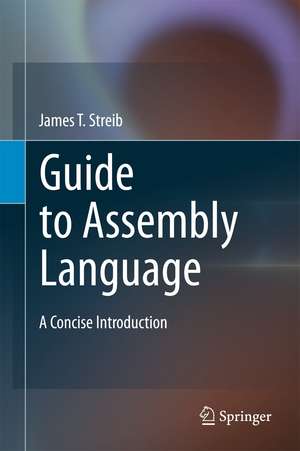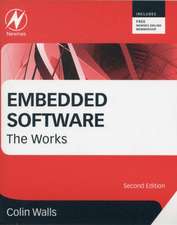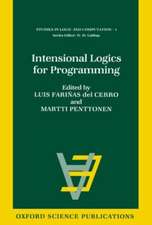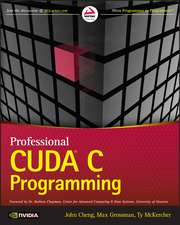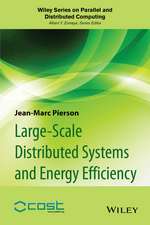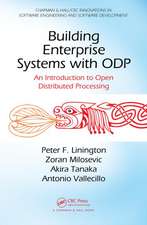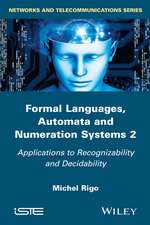Guide to Assembly Language: A Concise Introduction
Autor James T. Streiben Limba Engleză Paperback – 15 aug 2014
| Toate formatele și edițiile | Preț | Express |
|---|---|---|
| Paperback (2) | 337.25 lei 6-8 săpt. | |
| Springer International Publishing – 24 ian 2020 | 337.25 lei 6-8 săpt. | |
| SPRINGER LONDON – 15 aug 2014 | 416.41 lei 6-8 săpt. |
Preț: 416.41 lei
Preț vechi: 520.51 lei
-20% Nou
Puncte Express: 625
Preț estimativ în valută:
79.71€ • 86.61$ • 66.100£
79.71€ • 86.61$ • 66.100£
Carte tipărită la comandă
Livrare economică 22 aprilie-06 mai
Preluare comenzi: 021 569.72.76
Specificații
ISBN-13: 9781447158707
ISBN-10: 1447158709
Pagini: 272
Ilustrații: XIV, 257 p.
Dimensiuni: 155 x 235 x 14 mm
Greutate: 0.39 kg
Ediția:2011
Editura: SPRINGER LONDON
Colecția Springer
Locul publicării:London, United Kingdom
ISBN-10: 1447158709
Pagini: 272
Ilustrații: XIV, 257 p.
Dimensiuni: 155 x 235 x 14 mm
Greutate: 0.39 kg
Ediția:2011
Editura: SPRINGER LONDON
Colecția Springer
Locul publicării:London, United Kingdom
Public țintă
Lower undergraduateCuprins
Variables, Registers, and Data Movement.- Input/Output.- Arithmetic Instructions.- Selection Structures.- Iteration Structures.- Logic, Shifting, Rotating, and Stacks.- Procedures and Macros.- Arrays.- Strings.- Selected Machine Language Instructions.
Recenzii
From the reviews:
“The well-organized book is divided into ten chapters and five appendixes. The ten chapters follow a fairly standard layout for a book on this language, with each chapter concluding with a summary section and an appropriate set of exercises … . Summing Up: Recommended. All readership levels.” (J. Beidler, Choice, Vol. 49 (2), October, 2011)
“It teaches assembly language with precision and verve, and it also provides the reader with some understanding of the computer architecture that drives assembly language. … This book is an excellent text for a course in assembly language programming, and for programmers who want to understand the low-level operations and constructs that underlie high-level languages. Its attention to machine issues also makes it suitable as a supplemental text in a course on computer operations or architecture.” (Marlin Thomas, ACM Computing Reviews, August, 2011)
“The well-organized book is divided into ten chapters and five appendixes. The ten chapters follow a fairly standard layout for a book on this language, with each chapter concluding with a summary section and an appropriate set of exercises … . Summing Up: Recommended. All readership levels.” (J. Beidler, Choice, Vol. 49 (2), October, 2011)
“It teaches assembly language with precision and verve, and it also provides the reader with some understanding of the computer architecture that drives assembly language. … This book is an excellent text for a course in assembly language programming, and for programmers who want to understand the low-level operations and constructs that underlie high-level languages. Its attention to machine issues also makes it suitable as a supplemental text in a course on computer operations or architecture.” (Marlin Thomas, ACM Computing Reviews, August, 2011)
Textul de pe ultima copertă
Although the need for assembly language programmers has decreased, the need to understand assembly language has not, and it is important to actually write assembly language code if one is to understand it thoroughly.
This Guide to Assembly Language will enable the reader to very quickly begin programming in assembly language. Through this hands-on programming, readers will also learn more about the computer architecture of the Intel 32-bit processor, as well as the relationship between high-level and low-level languages. The book can either be used as a stand-alone text in a one-semester course on assembly language, or as a supplementary text in a computer organization and architecture course.
Topics and features:
Dr. James T. Streib is Professor and Chair of Computer Science at Illinois College, Jacksonville, Illinois USA.
This Guide to Assembly Language will enable the reader to very quickly begin programming in assembly language. Through this hands-on programming, readers will also learn more about the computer architecture of the Intel 32-bit processor, as well as the relationship between high-level and low-level languages. The book can either be used as a stand-alone text in a one-semester course on assembly language, or as a supplementary text in a computer organization and architecture course.
Topics and features:
- Presents an overview of assembly language, and an introduction to general purpose registers
- Illustrates the key concepts of each chapter with complete programs, chapter summaries, and exercises (with answers to selected exercises provided in the Appendices)
- Covers input/output, basic arithmetic instructions, selection structures, and iteration structures
- Introduces logic, shift, arithmetic shift, rotate, and stack instructions
- Discusses procedures and macros, and examines arrays and strings
- Investigates machine language from a discovery perspective
- Provides an overview of binary and hexadecimal, logic, and arithmetic in the Appendices, together with a Glossary, and a section on Visual C++ and MASM
Dr. James T. Streib is Professor and Chair of Computer Science at Illinois College, Jacksonville, Illinois USA.
Caracteristici
Readers will very quickly learn how to begin programming in assembly language Provides a hands-on approach that will enable readers to learn about the computer architecture of the Intel 32-bit processor, and the relationship between high-level and low-level languages Illustrates the key concepts of each chapter with complete programs, chapter summaries, and exercises, supported by further material in the Appendices Includes supplementary material: sn.pub/extras
Notă biografică
Dr. James T. Streib is Professor Emeritus of Computer Science at Illinois College, Jacksonville, IL, USA. His other publications include the Springer textbooks Guide to Data Structures and Guide to Java.
